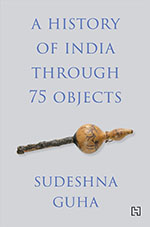History is an ever-evolving subject. Historians have, in recent times, attempted to study this subject through various novel ways. And understanding the human past through historical objects is one such technique which has become quite popular in recent times. Sudeshna Guha’s latest work A History of India through 75 Objects belongs to this category of history writing. The book contains short but crisp discussions on seventy-five objects and their relevance in Indian history. The monograph covers an extensive time-frame from prehistoric to modern times.
The artefacts encompassed in the present study belong to a range of categories including the mundane, the exotic, the royal and the non-royal. Rather than discussing them in isolation, Guha views them against the backdrop of changing socio-political scenarios. Through a detailed analysis she tries to explore the process through which an object transforms from being just a commodity, either of value or not, to an important historical source. The work also takes into account some of the issues related with studying such historical objects. An important issue among them pertains to the meaning attributed to the objects. Historians have, on many occasions, perceived objects from the point of view of the present. In the process, Guha argues, the original meaning and purpose of the object have often got lost. This is especially true of artefacts like the Pallavaram Spear Head, the Dancing Girl and Indus Scale, among others which belong to the remote past.

